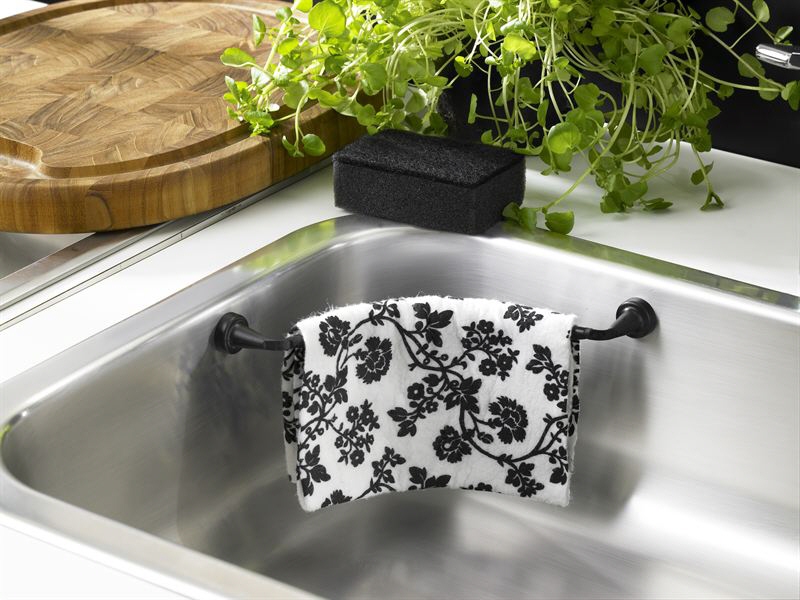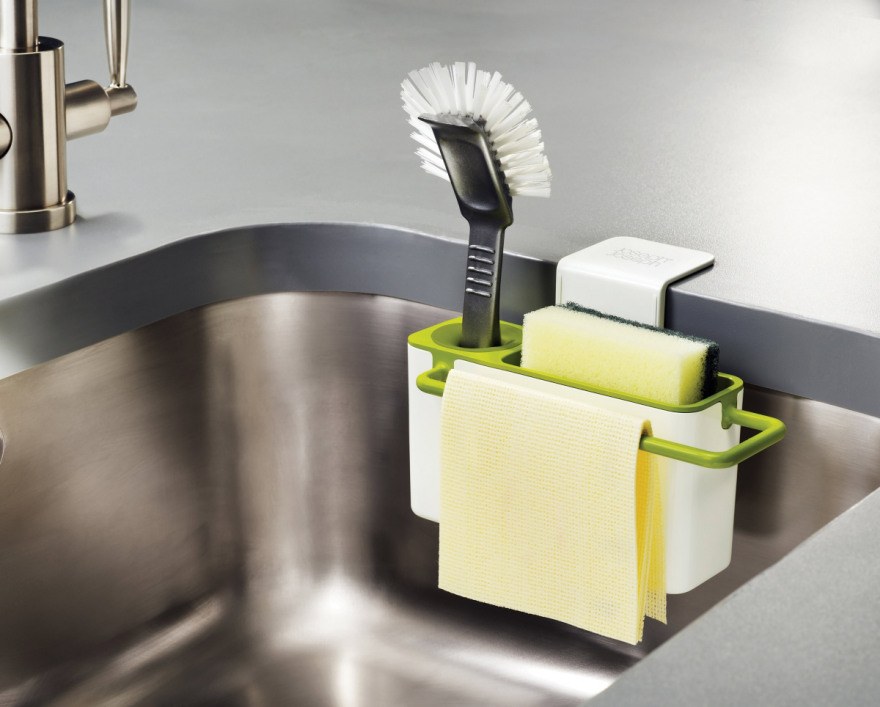Everyone has his or her preferred way to wash the dishes; people use sponges, dish clothes, brushes and more. When creating kitchen sink organizers, some designers create products intended to hold a specific cleaning tool, while others go for multi-purpose organizers. Sink sizes are styles are another consideration when designing this type of organizer.
Reenbergs magnetic cloth rail (which seems to be the same as the Skoy Rail) attaches with a magnet built into the end of the rail and another strong magnet that goes on the back side of the sink—so it will only work if that back side is reachable. The Reenbergs version comes in two lengths, and it has an option for stronger magnets to work with Corian, Silgranit and similar sinks. Those are both wise options to ensure the rail can work for most end users. Purchasers note that these dual magnets really work; some mention how much better they are than suction-cup products they tried in the past.
The rail comes with stickers to hold those back magnets in place if the rail is removed to clean the sink, but some purchasers have noted the stickers don't always hold. Skoy notes that something stronger, like duct tape, might be needed—especially if the sink has a rough underneath surface.
Reenbergs also has a flexible rail that can be used in corners, which may be more convenient for some end users—and might allow for a better fit in small sinks, where even the shorter rail could be too long. This one is entirely plastic, and comes in a choice of nine colors.
Magisso takes a different approach to the magnetic cloth holder, with an arm that extends out from a magnetic base. Again, a second magnet on the back side of the sink keeps the holder in place.
There's nothing provided to hold the rear magnet in place if the holder is removed to clean the sink—but the holder has a swivel arm (straight or curved) that can be readily removed from the magnetized base, so cleaning around it should be pretty easy. The swivel arm allows the end user to keep the cloth close to the side of the sink during the day (so it's not in the way) but move it out toward the center of the sink for better drying when the sink is not in use.
Magisso also has a magnetic sponge holder and a magnetic brush holder for those who use different cleaning tools.
Of course, sponge holders can also sit by the side of the sink. The OXO Good Grips sponge holder accommodates two sponges or scrubbers. It has open sides and bottom vents for air circulation, and the drip tray is removable for easy cleaning. One potential drawback noted by some purchasers: The holder is shorter than many sponges. Depending on the countertop material, how drippy the sponges are and how fussy the end user is about little puddles, this could be an issue. Also, some purchasers wish this holder had some kind of non-skid feet; as is, it's a lightweight item that often moves around when removing or replacing sponges.
![]()
The Spongester also holds two sponges, but is designed specifically to allow an end user to keep track of which sponge is used for washing dishes vs. which sponge is used for grubbier tasks like cleaning the sink or the stove. (If one sponge goes from being the "good" sponge to the "evil" sponge over time, or if the end user likes the simplicity of buying a single type of sponge, then getting two different colors or styles of sponges won't solve the problem of knowing which is which.)
The Joseph Joseph countertop sink caddies (large and small) can hold everything used for dishwashing, including the liquid soap in a not-too-large bottle. Some end users really like having an integrated all-in-one organizer, while others will find it somewhat silly to put the soap bottle into a caddy like this. The one complaint some purchasers have is that the section which holds the brush and soap has no drainage holes.
The Sink Storage Helper from Ippinka caught my eye for one nice feature: the ring holder. This would be really handy for end users who remove their rings when doing the dishes.
End users with limited counter space might prefer in-sink caddies, such as the Sink Aid from Joseph Joseph with spaces for a sponge, a brush and a dish cloth. This does use suction cups; some purchasers found they worked fine, while others had problems with them. One other concern: The opening for the brush isn't large enough for some brush handles.
Simplehuman has two sink caddies: the slim one holds two sponges side by side while the larger one also holds a brush. Again, some purchasers have had problems with the suction cups, but Simplehuman offers suction cup stickers to help keep the suction cups in place. The brush holder has a pop-out silicone base so it can extend downward to hold taller brushes.
The UMBRA saddle sink caddy designed by Ross + Doell is intended for standard double sinks—but some divided sinks have a center strip that's too wide for the saddle. For the right sink, though, it's a simple way to store a couple sponges or scrubbers.
Casabella's Sink Sider Faucet Sponge Holder is designed for sinks that are not divided. (I've seen photos of it being used in divided sinks, and that seems awkward.) It has adjustable straps to fit around most faucets. It's not deep enough for many scrub brushes, though, and some larger sponges may not fit. As with any such product, it's not for everyone.
One final note: For many of these products there were complaints from some purchasers about rust (for some of the stainless steel products) and mold that was hard to remove (for the rubber or plastic products, or parts of products). Anything a designer can do to minimize such problems would certainly be welcomed: avoiding hard-to-clean crevices, ensuring adequate drainage, etc.
![]()





















































































